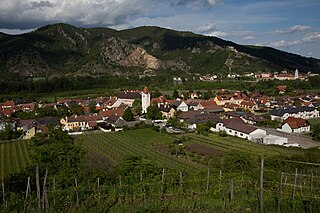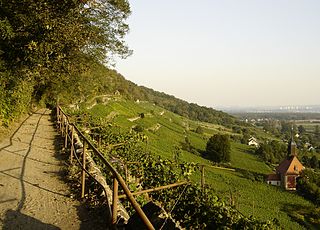Related Research Articles

Riesling is a white grape variety which originated in the Rhine region. Riesling is an aromatic grape variety displaying flowery, almost perfumed, aromas as well as high acidity. It is used to make dry, semi-sweet, sweet, and sparkling white wines. Riesling wines are usually varietally pure and are seldom oaked. As of 2004, Riesling was estimated to be the world's 20th most grown variety at 48,700 hectares, but in terms of importance for quality wines, it is usually included in the "top three" white wine varieties together with Chardonnay and Sauvignon blanc. Riesling is a variety which is highly "terroir-expressive", meaning that the character of Riesling wines is greatly influenced by the wine's place of origin.

Grüner Veltliner is a white wine grape variety grown primarily in Austria, Hungary, Slovakia, and the Czech Republic. The leaves of the grape vine are five-lobed with bunches that are long but compact, and deep green grapes that ripen in mid-late October in the Northern Hemisphere.
Wachovia was the area settled by Moravians in what is now Forsyth County, North Carolina, US. Of the six eighteenth-century Moravian "villages of the Lord" established in Wachovia, today, the town of Bethania, North Carolina and city of Winston-Salem exist within the historic Wachovia tract. The Moravian Archives in Winston-Salem has a map of the original Wachovia tract, showing the approximate locations of the first six Moravian congregations and the approximate current boundaries of Winston-Salem and Forsyth County.

In eastern Austria, a Heuriger is a tavern where local winemakers serve their new wine under a special licence in alternate months during the growing season. The Heurige are renowned for their atmosphere of Gemütlichkeit shared among a throng enjoying young wine, simple food, and - in some places - Schrammelmusik. They correspond to the Straußwirtschaften in the German Rheinland, the Frasche in Friuli-Venezia Giulia, and Osmiza in Slovenia.

Pasching is a municipality in the Austrian state of Upper Austria. It is situated a few miles southwest of Linz and borders Leonding, Hörsching, Wilhering and Traun.
Apricot brandy can refer to a liquor distilled from fermented apricot juice or a liqueur made from apricot flesh and kernels.
The glossary of wine terms lists the definitions of many general terms used within the wine industry. For terms specific to viticulture, winemaking, grape varieties, and wine tasting, see the topic specific list in the "See also" section below.

Austrian wines are mostly dry white wines, though some sweeter white wines are also produced. About 30% of the wines are red, made from Blaufränkisch, Pinot noir and locally bred varieties such as Zweigelt. Four thousand years of winemaking history counted for little after the "antifreeze scandal" of 1985, when it was revealed that some wine brokers had been adulterating their wines with diethylene glycol. The scandal destroyed the market for Austrian wine and compelled Austria to tackle low standards of bulk wine production, and reposition itself as a producer of quality wines. The country is also home to Riedel, makers of some of the most expensive wine glasses in the world. Some of the best producers of Austria include Weingut Bründlmayer, Weingut F.X. Pichler and Weingut Franz Hirtzberger, Weingut Hutter, Weingut Eigl and Wellanschitz.

Rossatz-Arnsdorf is a town in the district of Krems-Land in the Austrian state of Lower Austria. It is located in the Wachau valley of the Danube, a popular destination for tourists, and has excellent views of the ruins of castle Dürnstein, where King Richard the Lion-Heart of England was held captive by Duke Leopold V.

Spitz an der Donau is a market town in the district of Krems-Land in the Austrian state of Lower Austria, in the midst of the UNESCO World Heritage area Wachau, further down from Willendorf on the left bank of the Danube. The ferry across the Danube here is interesting in that it has no motor or sail: it is powered by rudder set against the river current, anchored to a cable above the river. The ferry carries passengers, bicycles, motorcycles, and automobiles.

Saxony (Sachsen) is a region for quality wine in Germany located in the German federal state of Saxony. The region is sometimes referred to colloquially as the Elbtal. The wine region covers 462 hectares, which makes it Germany's third smallest region, just ahead of Mittelrhein and Hessische Bergstraße in size. It is situated along the Elbe river from the Pillnitz section of Dresden to the village of Diesbar-Seußlitz located north of Meissen. Together with the Saale-Unstrut wine region, Saxony is one of the northernmost wine regions in Europe and are the only two of Germany's 13 wine regions that are located in the former East Germany. After German reunification in 1990, the vineyard surface was expanded from 200 to 450 hectares with European Union subsidies, but in recent years the vineyard area has decreased.
The Krems is a river in Waldviertel in northern Lower Austria. There are actually two rivers: the so-called "Große Krems", denoting either the whole river system or the main tributary only, and the smaller one called "Kleine Krems". The Krems originally flowed into the Danube by Krems an der Donau, but when the Danube power station Altenwörth was built at Altenwörth, the mouth of the river — together with that of the Kamp — was moved to Altenwörth.

The Wachau is an Austrian valley with a picturesque landscape formed by the Danube river. It is one of the most prominent tourist destinations of Lower Austria, located midway between the towns of Melk and Krems that also attracts "connoisseurs and epicureans" for its high-quality wines. It is 36 kilometres (22 mi) in length and was already settled in prehistoric times. A well-known place and tourist attraction is Dürnstein, where King Richard the Lionheart of England was held captive by Duke Leopold V of Austria and Styria. The architectural elegance of its ancient monasteries, castles and ruins combined with the urban architecture of its towns and villages, and the cultivation of vines as an important agricultural produce are the dominant features of the valley.

Wachau is one of Austria's most established and notable wine regions, specializing in dry wines made from Riesling and Grüner Veltliner. Located in Lower Austria along the Danube, west of Vienna and Krems an der Donau, it is one of the westernmost wine producing regions in Austria with only a few scattered plantings in Tyrol being further west. While most of Austria follows a wine classification systems based on ripeness and harvest must weight that parallels the German wine classification system, Wachau wines have a unique classification system. The three classification levels for Wachau wine include Steinfeder for wines up to 11.5% alcohol level, Federspiel for wines between 11.5–12.5% and Smaragd that must have a minimum of 12.5% alcohol level. Despite its renown, the Wachau is a small wine region that usually accounts for only around 3% of Austria's wine production.

Districtus Austriae Controllatus, DAC, is a classification for regionally typical quality wine in Austria. It is loosely modelled on the French Appellation d'Origine Contrôlée (AOC) system, and is coupled with a ripeness-based classification scale that shares a lot of nomenclature with the German Prädikat system. Thus, if a label states the winegrowing region followed by the letter combination “DAC” we are talking about a regionally typical quality wine. All Austrian quality wines have a round, red and white striped "Banderole" on the capsule, which ensures, that it has been inspected and approved by the government tasting authority and fulfills the requirements for “Qualitätswein”, such as maximum yields per hectare, minimum must weight and alcohol levels and guaranteed origin of the grapes.
Kremstal DAC is an official wine region in Austria. The first vintage was 2006. Allowed grape varieties are Grüner Veltliner or Riesling. The wine must be vinified to an Alcohol by volume of 12% or greater. Grüner Veltliner must be fresh, fruit-driven aromas, aromatic, with gentle spice, and no botrytis or oak notes. Riesling must be aromatic, with intensive stone fruit aromas, elegant, mineral notes, and no botrytis or oak notes. Reserve wines wine must be vinified to an Alcohol by volume of minimum of 13%; subtle botrytis and oak aging aromas are allowed for Reserve wines.
Federspiel is a Germanic surname that literally means "feather play". The name originates in Switzerland. Notable people with the surname include:
Wachau may refer to:

Willendorf, or when ambiguous Willendorf in der Wachau, is a village in the Wachau valley in Lower Austria.
References
- ↑ map Archived 3 July 2007 at the Wayback Machine
| | This wine-related article is a stub. You can help Wikipedia by expanding it. |
| | This Austria-related article is a stub. You can help Wikipedia by expanding it. |